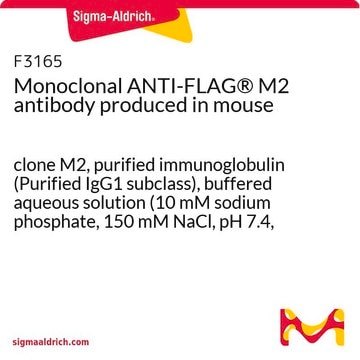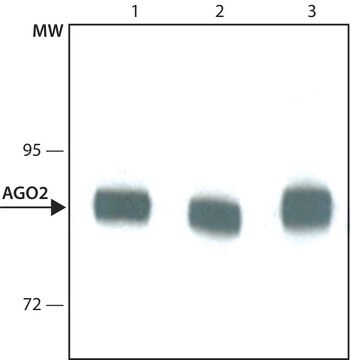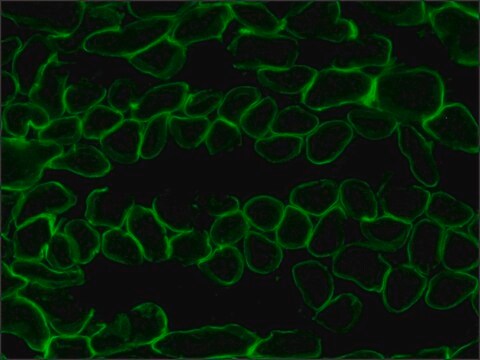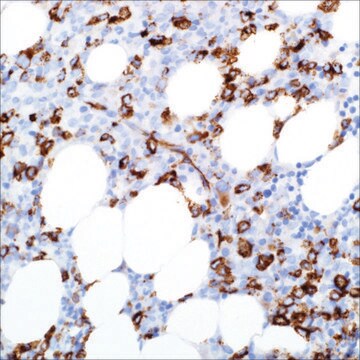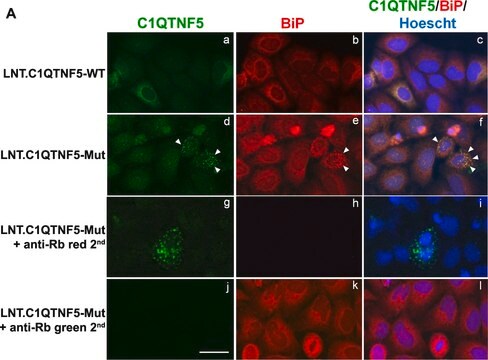MABN2304
Anti-Legumain/Asparaginyl endopeptidase antibody Clone 6E3
Sign Into View Organizational & Contract Pricing
Select a Size
All Photos(3)
Select a Size
Change View
About This Item
UNSPSC Code:
12352203
NACRES:
NA.74
Recommended Products
biological source
mouse
Quality Level
conjugate
unconjugated
antibody form
purified antibody
antibody product type
primary antibodies
clone
6E3, monoclonal
mol wt
calculated mol wt 49.41 kDa
observed mol wt ~55 kDa
purified by
using protein G
species reactivity
human, mouse
packaging
antibody small pack of 100 μg
General description
Legumain (UniProt: Q99538; also known as EC: 3.4.22.34, Asparaginyl endopeptidase, AEP, Protease cysteine 1, Delta Secretase) is encoded by the LGMN (also known as PRSC1) gene (Gene ID: 5641) in human. AEP is a lysosomal endopeptidase that displays strict specificity for the hydrolysis of asparaginyl bonds and can simultaneously cleave both amyloid precursor protein (APP) and tau. It cleaves aspartyl bonds slowly, especially under acidic conditions. AEP is synthesized with a signal peptide (aa 1-17) and a propeptide (aa 324-433) that are cleaved off in the mature form. It exists a homodimer before removal of the propeptide and after autocatalytic processing exists as a monomer. In its zymogen form, the uncleaved propeptide blocks access to the active site. AEP is phosphorylated on serine 226 by serine-arginine protein kinase 2 (SRPK2), which accelerates its autocatalytic cleavage and enhances its enzymatic activity. The active form translocates to cytoplasm. In Alzheimer s disease brains AEP is reported to be highly phosphorylated. Depletion of AEP is shown to reduce amyloid peptide production and senile plaque formation in 5XFAD mouse brain that leads to restoration of synaptic activity and cognitive function. Three isoforms of AEP have been described that are produced by alternative splicing. (Ref.: Wang Z-H., et al. (2017). Mol. Cell 67(5); 812-825; Zhang, Z et al (2015). Nat. Commun. 6; 9762).
Specificity
Clone 6E3 is a mouse monoclonal antibody that specifically detects Legumain (AEP).
Immunogen
His-tagged full-length recombinant human legumain.
Application
Quality Control Testing
Evaluated by Western Blotting in SH-SY5Y cell lysate.
Western Blotting Analysis: A 1:1000 dilution of this antibody detected Legumain/AEP in SH-SY5Y cell lysate.
Tested Applications
Western Blotting Analysis: A 1:1,000 dilution from a representative lot detected Legumain/AEP in mouse brain tissue lysate.
ELISA Analysis: A representative lot detected Legumain/AEP in ELISA applications (Mattock, K.L., et al. (2010). Atherosclerosis.208(1):83-9; Kang, S.S., et al. (2018). EMBO J. 37(12):e98878).
Immunoprecipitation Analysis: A representative lot immunoprecipitated legumain/AEP in Immunoprecipitation applications (Zhang, Z., et al. (2015). Nat Commun. 6:8762).
Immunohistochemistry (Paraffin) Analysis: A 1:50 dilution from a representative lot detected Legumain/AEP in human placenta tissue sections.
Immunocytochemistry Analysis: A representative lot detected Legumain/AEP in Immunocytochemistry applications (Li, D.N., et al. (2003). J. Biol. Chem. 278(40):38980-90; Wang, Z-H., et al. (2019). Cell Rep. 28(3):655-669).
Western Blotting Analysis: A representative lot detected Legumain/AEP in Western Blotting applications (Probst-Kepper, M., et al. (2009). J Cell Mol Med.;13(9B):3343-57; Zhang, Z., et al. (2015). Nat Commun.;6:8762; Wang, Z-H., et al. (2017). Mol Cell.;67(5):812-825; Zhang, Z., et al. (2017). Nat Struct Mol Biol.;24(8):632-642; Kang, S.S., et al. (2018). EMBO J.;37(12):e98878; Wang, Z-H., et al. (2018). Nat Commun.;9(1):1784; Wang, Z-H., et al. (2018). JCI Insight.;3(16):e99007; Wang, Z-H., et al. (2019). Cell Rep.;28(3):655-669).
Note: Actual optimal working dilutions must be determined by end user as specimens, and experimental conditions may vary with the end user
Evaluated by Western Blotting in SH-SY5Y cell lysate.
Western Blotting Analysis: A 1:1000 dilution of this antibody detected Legumain/AEP in SH-SY5Y cell lysate.
Tested Applications
Western Blotting Analysis: A 1:1,000 dilution from a representative lot detected Legumain/AEP in mouse brain tissue lysate.
ELISA Analysis: A representative lot detected Legumain/AEP in ELISA applications (Mattock, K.L., et al. (2010). Atherosclerosis.208(1):83-9; Kang, S.S., et al. (2018). EMBO J. 37(12):e98878).
Immunoprecipitation Analysis: A representative lot immunoprecipitated legumain/AEP in Immunoprecipitation applications (Zhang, Z., et al. (2015). Nat Commun. 6:8762).
Immunohistochemistry (Paraffin) Analysis: A 1:50 dilution from a representative lot detected Legumain/AEP in human placenta tissue sections.
Immunocytochemistry Analysis: A representative lot detected Legumain/AEP in Immunocytochemistry applications (Li, D.N., et al. (2003). J. Biol. Chem. 278(40):38980-90; Wang, Z-H., et al. (2019). Cell Rep. 28(3):655-669).
Western Blotting Analysis: A representative lot detected Legumain/AEP in Western Blotting applications (Probst-Kepper, M., et al. (2009). J Cell Mol Med.;13(9B):3343-57; Zhang, Z., et al. (2015). Nat Commun.;6:8762; Wang, Z-H., et al. (2017). Mol Cell.;67(5):812-825; Zhang, Z., et al. (2017). Nat Struct Mol Biol.;24(8):632-642; Kang, S.S., et al. (2018). EMBO J.;37(12):e98878; Wang, Z-H., et al. (2018). Nat Commun.;9(1):1784; Wang, Z-H., et al. (2018). JCI Insight.;3(16):e99007; Wang, Z-H., et al. (2019). Cell Rep.;28(3):655-669).
Note: Actual optimal working dilutions must be determined by end user as specimens, and experimental conditions may vary with the end user
Anti-LGMN/AEP, clone 6E3, Cat. No. MABN2304, is a mouse monoclonal antibody that detects Legumain and is tested for use in ELISA, Immunocytochemistry, Immunohistochemistry (Paraffin), Immunoprecipitation, and Western Blotting.
Physical form
Purified mouse monoclonal antibody IgG1 in buffer containing 0.1 M Tris-Glycine (pH 7.4), 150 mM NaCl with 0.05% sodium azide.
Storage and Stability
Recommend storage at +2°C to +8°C. For long term storage antibodies can be kept at -20°C. Avoid repeated freeze-thaws.
Other Notes
Concentration: Please refer to the Certificate of Analysis for the lot-specific concentration.
Disclaimer
Unless otherwise stated in our catalog or other company documentation accompanying the product(s), our products are intended for research use only and are not to be used for any other purpose, which includes but is not limited to, unauthorized commercial uses, in vitro diagnostic uses, ex vivo or in vivo therapeutic uses or any type of consumption or application to humans or animals.
Not finding the right product?
Try our Product Selector Tool.
Storage Class
12 - Non Combustible Liquids
wgk_germany
WGK 1
flash_point_f
Not applicable
flash_point_c
Not applicable
Certificates of Analysis (COA)
Search for Certificates of Analysis (COA) by entering the products Lot/Batch Number. Lot and Batch Numbers can be found on a product’s label following the words ‘Lot’ or ‘Batch’.
Already Own This Product?
Find documentation for the products that you have recently purchased in the Document Library.
Our team of scientists has experience in all areas of research including Life Science, Material Science, Chemical Synthesis, Chromatography, Analytical and many others.
Contact Technical Service

